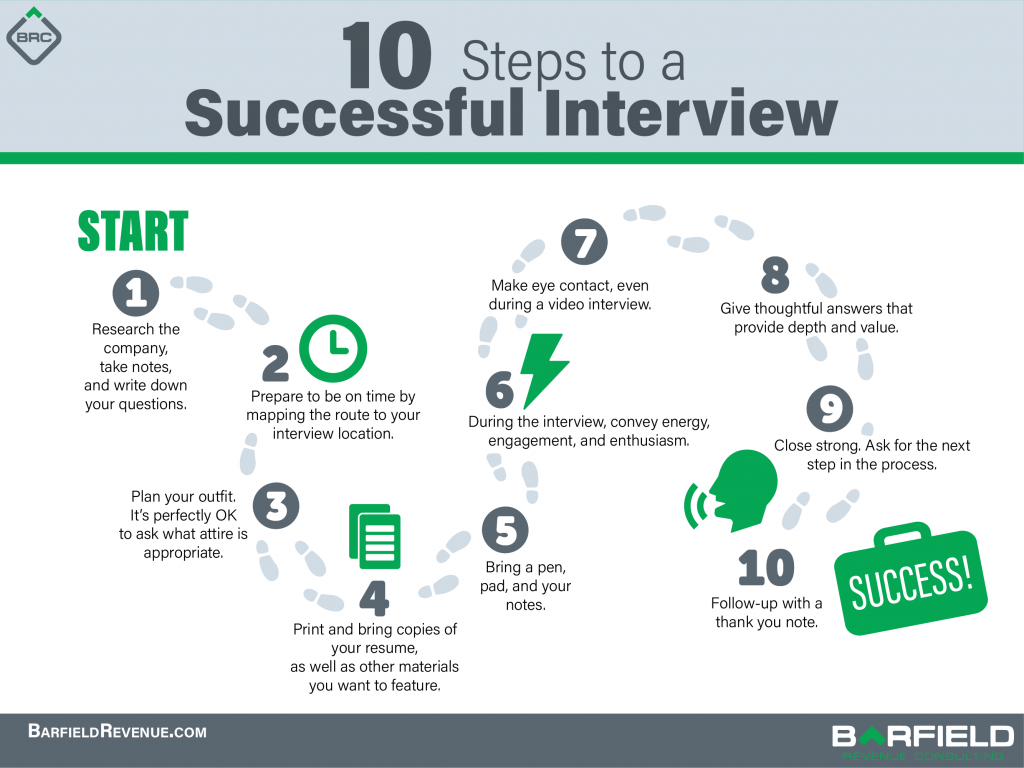
Image by Mohamed Hassan
Job interview processes are stressful, and we field a lot of questions about the best ways to prepare for — and to execute — an interview. Most people have never received any sort of interview training, and if they are employed on a consistent basis, chances are that they don’t have a plethora of opportunities to practice. As a result, even with senior-level candidates, I often see a shortfall in the interview performance department.
Last week, we wrote about closing your interviews with a strong message of interest. But that part happens at the end. There are MANY steps along the way that you can take to stand out as a candidate. Several of these may seem almost elementary, yet many people don’t take the time to do them — or to do them well.
Step One: Do your research and come with questions.
Thoroughly look into the company and your interviewer. And read the job description several times. With all of the online tools available at your fingertips, there is no excuse for not being incredibly prepared on the research side. What’s the company’s mission? Where did your interviewer go to college? Which of the job responsibilities did you CRUSH in your most recent role? Come ready to show that you know your stuff and that you are super relatable.
During the course of your research and your job description scrubbing, questions inevitably will pop into your head. Write them down. Or note them on your iPad or tablet or phone. Interviewers really appreciate it when candidates come to the party with thoughtful questions. It exhibits interest, preparedness, and a desire to win the interview.
Step Two: Prepare to be on time.
Whether it’s the first phone screen or an in-person interview, you must be timely. If you are the one calling, do not be late. If you are supposed to call at 2:00, call at 2:00. If it looks like you might be running late, reach out ahead of time via email and/or text and explain why. And please don’t call early. It’s not impressive to be early to a phone interview. It’s actually irritating. Most interviewers are heading into your call straight from another commitment, so calling early is an inconvenience.
Speaking of being inconvenient, don’t be super early for a face-to-face interview. Your goal should be to arrive five minutes early. Do not arrive 15 or more minutes early, it’s discourteous. Your interviewer should not have to worry about you sitting in the lobby for 15 minutes with time to kill. Plus, you could cross paths with other candidates, which can be awkward and is certainly not the interviewer’s intention.
As part of your in-person interview preparation, make the trek to the site on a prior day and do so during the same time of day. See how long it takes you to make the trip so you can get an accurate sense of the amount of time needed, traffic included. You do not want to run the risk of being late or sliding in right at the scheduled time.
Step Three: Prepare your look/attire.
Work attire has changed a lot over the years. If you aren’t sure what clothing will be appropriate for the interview (video or on-site), ask in advance. You don’t want to be overdressed or underdressed. You don’t want to fail to fit correctly with either the company vibe or the interviewer’s expectations. Inquire ahead of time, and your point of contact will appreciate that you want to get it right. It’s definitely not cool to don a suit for a “T-shirt and jeans” setting.

Step Four: Print and bring with you copies of your resume.
Yes, many people prefer an electronic format and may have your resume on their screen during the meeting. But you don’t know for sure, and you want to be prepared. Additionally, bring one more copy with you than you think you’ll need. If the exchange is going well, the person with whom you are meeting might grab a colleague and ask her or him to join. Stay one step ahead by having a spare copy.
Step Five: Bring something to write with and something to write on.
Please have what you need in order to take notes, whether it’s an in-person interview or a phone call. You’re not sending the right message otherwise. There’s no reason to step into an interview situation without a pen or a pad or a device you can use to take notes. Period. Ever. Interviewers like to see that you are taking notes and highlighting key points. And if it’s a phone call, some of the factors you jot down will be great to bring up later in the conversation as thoughtful questions.
Step Six: Convey energy, engagement, and enthusiasm (3 Es).
These points apply to both phone or face-to-face communication, whether via video or in person.
Step Seven: Make eye contact.
You would be surprised at how few people do this well and how much it matters. Making eye contact can be difficult and uncomfortable for some, particularly when meeting a person for the first time, or if they are feeling nervous or anxious. Nonetheless, it’s critical in interviews, whether in person or via video. Interviewers are looking to make a connection.
Hiring is not just about skills and abilities, it’s also about fit and feel. A lot of decisions are made about a candidate during those moments of direct eye contact. Have a smile on your face, fabulous posture, and look ‘em straight in the eye. When it comes to video interviews, make a point of looking at the camera when your talking or when you’re processing a question from the interviewer. It’s not easy, but it’s very impactful.
Step Eight: Give answers that provide depth and value.
Do not answer even the shortest and most simple of questions with a reflexively short answer. “Yes/no” questions absolutely cannot receive a “yes/no” response. Respond thoughtfully, showing a depth of processing. Add value to the interview exchange by offering up insightful commentary.
However, on the flip side, be careful not to get too verbose. When we are nervous, it’s easy to overtalk/overshare in order to compensate for our anxiousness. A good rule of thumb is to keep an answer to 30 seconds or so, unless it’s clear that the interviewer has teed you up for a very detailed response that could take a minute or more. Don’t meander off track, either. If you end up in long-winded rambles too frequently during the conversation, your interviewer is going to disengage, and your odds at landing the job are going to get much worse.
Step Nine: Close strong.
We covered more on this one in our last blog post, so check that out.
Step Ten: Follow up.
Writing a “thank you” note has become a lost art. Help us bring it back. Whether it’s via email or snail mail, DO IT. The follow-up thank you note should be considered an extension of the interview process. When you craft yours, demonstrate that you were fully engaged in the exchange. Include a sentence or two that bring up critical points made by the interviewer, and tie those back to you strengths as a candidate. Convey your gratitude for the interviewer’s time, and close the note with a reaffirmation of your interest in the job.
Of course, re-read what you’ve written (multiple times), making sure it looks nice, has correct spelling and grammar, and sounds smooth and professional. Thank you notes are like post-interview cover letters. They provide you with a chance to exhibit your writing skills and to show that you are a well-rounded, top-notch candidate.
Final Note
While job interviews are stressful, if you approach them with the proper amount of preparation and dedication, you will have no trouble standing out from your interview competition.
Reach out to us for help finding your next revenue-generating sales or marketing job. We’ve done a few interviews in our day!